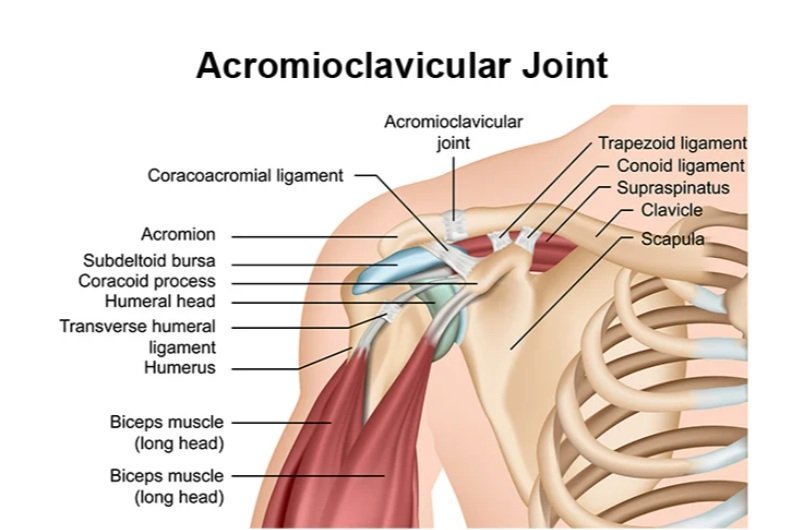Physical Therapy for a Shoulder Separation
A shoulder separation, or AC joint injury, involves a strain or tear of the ligaments of the joint that result in some form of separation between the clavicle and acromion. Shoulder separations are common among young male athletes who participate in high-contact sports like football and rugby. Physical therapy is an effective treatment for AC joint shoulder separations, helping to manage pain, restore shoulder mobility and strength, and return to sport and work safely through a progressive four-phase rehabilitation program.
What is the AC Joint?
The acromioclavicular joint (AC joint) is located at the top of the shoulder where the front of the shoulder blade (the acromion) attaches to the collarbone (the clavicle). At the AC joint, there are four ligaments that hold the clavicle and acromion together. The acromioclavicular and coracoclavicular ligaments play key roles in supporting the AC joint. Together, the ligaments along with the dynamic muscle control of the deltoid and trapezius muscles provide stability to the joint.
Shoulder Separations: An AC Joint Injury
AC joint injury, or shoulder separation, involves a strain or tear of the ligaments of the joint that result in some form of separation between the clavicle and acromion. Shoulder separations are most common in those younger than 35 with men sustaining 5 times more AC joint injuries than women. Injury is common among young athletes in contact sports, such as football, rugby, and hockey. Reports have shown that 41% of college football players and 40% of NFL quarterbacks experience a shoulder separation during their careers. AC joint injuries also occur in high numbers in cycling and triathlon competitions.
A shoulder separation occurs most commonly due to a traumatic impact on the shoulder in which the ligaments of the AC joint are forced to stretch too far, leading to a sprain or tear and separation of the acromion and clavicle. This can result from a direct fall on the shoulder such as when tackled during football or a cycling crash.
Symptoms of shoulder separation include:
General shoulder pain and swelling
Swelling and tenderness over the AC joint
Loss of shoulder strength and motion
A visible bump just above the shoulder
Pain when lying on the involved side
Popping sound or feeling that the shoulder catches with movement
Discomfort during activities that stress the AC joint, such as lifting objects overhead, reaching across the body, and carrying objects at your side
There are various grades of shoulder separation, denoting the severity of the injury:
Grade 1 separation: This involves a sprain or slight tear in the AC ligament, but there is no damage to the coracoclavicular (CC) ligament and there is no clavicle displacement. Physical therapy can effectively address Grade 1 tears.
Grade 2 separation: This involves a completely torn AC ligament, and there’s little to no tear to the CC ligament. Physical therapy can effectively address Grade 2 tears.
Grade 3 separation: In this grade, both the AC and CC ligaments are completely torn. The collarbone separates from the end of the shoulder blade. Physical therapy can effectively address Grade 3 tears, although surgery may be needed if physical therapy does not address and minimize symptoms.
Grade 4, 5, & 6: These grades involve several tears of the AC and CC ligaments and require surgery.
Physical Therapy for Shoulder Separations
Physical therapy is an effective treatment for AC joint shoulder separations, helping to manage pain, restore shoulder mobility and strength, and return to sport and work safely.
Physical therapy treatment for a shoulder separation can include:
Pain and swelling management
Range of motion exercises to decrease muscle tension and help restore normal movement in the shoulder joint
Posture training
Manual therapy hands-on treatment to increase the mobility of the muscles and joints of the shoulder
Muscle strengthening of muscles of the shoulder, upper back, and chest to improve the stability and strength of the shoulder joint and relieve stress on the AC joint. Strengthening targets the trapezius, deltoid, rotator cuff, and scapular musculature. Core strengthening is also incorporated.
Functional training: once pain and mobility improve, functional training involves retraining of work and sport-specific activities through safe, controlled movements and correct positioning when lifting, throwing, or swinging.
Use of protective padding of the AC joint in athletes returning to collision sports.
Phase 1 (0-2 weeks): A brief period of immobilization with a sling helps to support the arm and shoulder and decreases stress on the AC joint.
Phase 2 (3-6 weeks): The therapist introduces gentle range of motion exercises and early strengthening of the scapular muscles to reduce AC joint stress by unloading the weight of the arm.
Phase 3 (7-12 weeks): During this stage, advanced dynamic strengthening of the shoulder girdle and periscapular muscles are incorporated to improve AC joint stability.
Phase 4 (12 weeks): At this stage, the patient can begin sport-specific training with advanced shoulder strengthening, kinetic chain exercises, and plyometric training.
For power athletes such as defensive linemen, pushups, bench presses, and overhead presses can be begun. Using a medicine ball, two-hand chest passes can be started with progression to single-hand activities.
For throwers, a graduated throwing program is initiated, starting at short distances and low velocity and advancing to an increased number of throws, longer distances, and balls thrown more on a direct line at higher velocity.
For other overhead athletes such as racquet sports players, ground strokes and then overhead serves can be initiated depending on the tolerance of symptoms.
Should surgery be required, an ACCR (anatomic coraclavicular reconstruction) surgery is performed in which the coracoclavicular ligament is reconstructed with a soft tissue allograft. Rehabilitation post-surgery is essential to regain full function and range of motion safely in the shoulder joint.
Have you experienced a separated shoulder? Work with a physical therapist today to manage pain, restore function, and return to sport safely!


